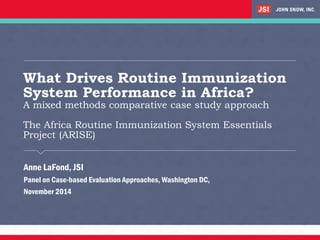What Drives Routine Immunization System Performance in Africa? A mixed methods comparative case study approach
- 1. What Drives Routine Immunization System Performance in Africa? A mixed methods comparative case study approach The Africa Routine Immunization System Essentials Project (ARISE) Anne LaFond, JSI Panel on Case-based Evaluation Approaches, Washington DC, November 2014
- 2. 2 Context History of investment in national immunization programs in Africa. Why does coverage improve in some settings and not in others? The Complexity: Many variables associated with high levels of immunization coverage but little understanding of the dynamics of coverage improvement.
- 3. 3 Methods ŌĆóMixed methods, multiple case studies ŌĆóCase selection: Countries with DPT3 coverage improvement ŌĆóNested case: Three districts per country with recent DPT3 coverage improvement and one district with steady or unchanged coverage Robert K. Yin 1984, p 23
- 4. 4 Design & Data Collection Focus on district level and the dynamics of change Mixed methods: Coverage trend analysis and verification; RI Situation Analysis (service readiness); Open-ended, semi structured key informant interviews district, facility, community levels; FGD; field observation. Iterative field level analysis by district Grounded theory building Interdisciplinary team: Routine immunization expert, researchers, country program Cross district case consistency Close collaboration with technical and country experts Country level validation (stakeholder workshop)
- 6. Addressing challenges ŌĆóQuality and availability of coverage data to select cases ŌĆóConsistent approach across country cases ŌĆóIntensive fieldwork stage with iterative analysis and theory building
- 7. Four Direct Drivers of RI Performance Improvement Cadre of Community Centered Health Workers Immunization Services Tailored to Community Needs Health System and Community Partnership Regular Review of Program and Health Worker Performance Improved Service Delivery Increased Acceptance and Use Improved Immunization Coverage
- 9. information For more information, please contact: Anne_LaFond@jsi.com thank you Funded by the Bill and Melinda Gates Foundation Implemented by Anne LaFond, Natasha Kanagat, Jenny Sequeira, Robert Steinglass, Rebecca Fields (JSI). Judith Justice (Ehtiopia), Cheikh Niang, (Cameroon) and Ann Larson (Ghana) In collaboration with Sangeeta Mookherji, George Washington University SPH









